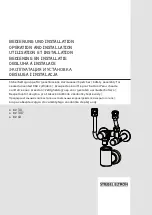
LAARS HEATING SYSTEMS
Page 16
6.
On each affected burner, slowly close the air
shutter until a normal flame is observed then re-
tighten its associated locking screw.
7.
Turn the boiler off.
8.
Perform System Start-Up in accordance with
Section 2A of this manual.
9.
Observe flame pattern on all burners. If the flame
on any burner is pulsing, unstable or lifting then
repeat steps 5 and 6 until all burners are
exhibiting a normal flame.
10.
Re-install the burner cover and tighten it in
place.
2A-3. Sequence of Operation
1.
Wall thermostat calls for heat.
2.
The damper activator rotates damper blade to
open position. Indicator light comes on.
3.
Pump relay will turn on the circulating pump.
4.
If water temperature is below the limit setting on
the spark ignition models will light the pilot and
check the flame existence.
5.
After pilot is proven to be lit, the main gas valve
will open, the main burners will ignite and
continue until either the hi-limit or wall
thermostat opens.
6.
When the wall thermostat is satisfied, the burners
will shut off. The pump relay will turn off the
pump, and the damper will close. When the room
temperature falls below the wall thermostat
setting, the cycle will repeat.
Note: When equipped with pump delay option,
the pump will run for short time after the burners turn
off and the damper closes.
2B. Water Temperature Setting
In Canada, for models equipped with modulating
gas valves, in addition to the main gas valve. These
controls are factory set at "5" which is satisfactory for
most installations. Lower settings may be appropriate
for radiant floor systems, or when heating
requirements are low. To change the factory setting
simply adjust the red knob on the valve to the desired
water temperature according to Table 7 (temperatures
are approximate).
2C. Maintenance
1.
Lubricate the water circulating pump per the
instructions on the pump.
2.
If a strainer is employed in a pressure reducing
valve or the piping, clean it every six months.
3.
At start-up, and periodically thereafter, the
burner flame should be observed. If the flame
has the appearance of 'sooting' tips, check for
debris near the orifices and call the service
technician.
4.
Inspect the venting system for obstruction,
leakage or corrosion at least once a year.
5.
Keep the boiler area clear and free from
combustible materials, gasoline, and other
flammable vapors and liquids.
6.
Be sure that all combustion air and ventilation
openings are unobstructed.
7.
Upon completion of the installation, inspect the
external surfaces of the heat exchanger for
fouling based on the following schedule:
24 hours 7 days 30 days 90 days
Once every six months thereafter.
8.
If the boiler is not going to be used for long
periods of time in locations where freezing
occurs, it should be completely drained of all
water. To accomplish this, there is a drain valve
on the right side of the boiler which can be
opened. This will drain the right side of the
boiler. There are two plugs located on the left
side of the heater which must be removed to
drain that side. Both sides must be drained.
9.
The gas and electric controls on the boiler are
engineered for long life and dependable
operation, but the safety of the equipment
depends on their proper functioning. It is
strongly recommended that the basic items listed
below be inspected by a qualified service
technician every year.
a.
Water temperature controls
b.
Pilot safety system.
c.
Automatic gas valves.
d.
Flow sensing safety devices.
e.
Vent dampers and power venters.
Figure 13.
1) JVS Pilot; 2) JVH Pilot;
3) Main Burner Flame Pattern; 4) JVT Pilot.
Table 7. Water Temperature Settings.
Dial
Number
1
2
3
4
5
6
7
8
9
Temp. °F 120
135
150
165
180
195
210
225
240
Temp. °C
49
57
66
74
82
91
99
107
116









































